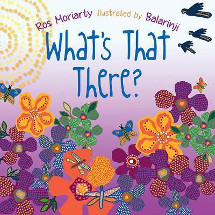What's that there? by Ros Moriarty

What's that there? by Ros Moriarty
Ill. by Balarinji. Allen and Unwin, 2017. ISBN 9781760297817
Bush tracks by Ros Moriaty, ill. Balarinji. Allen &
Unwin, 2018. ISBN 9781760297824
(Age: 3+) Highly recommended. Themes: Aboriginal themes.
Environment. Outback Australia. Australian flora and fauna.
Interaction. Indi Kindi (reading program). Each double page of What's
that there? begins with that question, and is followed by text
showing what the children are looking at in the illustration on the
other side of the page.
On one page, for example, is an illustration in more muted tones,
with bees buzzing around the brown circles of colour. The text tells
us that we are looking at fired tussocks, now sprouting, and bees
are swarming in the hollow trunk. The eye is drawn to the picture
and the things mentioned in the text recognised, while things seen
in the environment are sighted.
Each of the double pages follows this same format giving information
about the environment, a lively text telling the readers about the
plants and animals that inhabit it, while showing something
happening. Each is supported by colourful illustrations which dazzle
the eye, entreating readers to look more closely at the detail
shown.
And at the end of each in this wonderful series, the story is
reprised in Yanyuwa language, adding another layer of interest,
discussion and learning for any reader.
The second book Bush tracks, follows a different format than
the first, but is still as informative, lively and eye-catching.
This is written as if following a bush track, being shown what is
useful in the environment through which we are walking, as well as
giving warnings about things that may bite or snag along the way.
The two like the others in this series are wonderful to read, with
flowing, informative and detailed text, supported by magical
illustrations which demand closer attention.
Ros Moriaty co-founded the Nangala Project which
includes Indi Kindi early literacy education, and has won many
awards for business and citizenship. The Indi Kindi books are
promoted as being for young bush kids, but they would be welcome
anywhere where children are learning to read, learning about their
environment and learning to be part of the country which surrounds
them. Each of the books promotes observation and interaction,
learning about the animals and plants that inhabit the environment
and what part they play in it.
Each of these books leads children to understand more of the place
they live and for city kids, opens their eyes to what they can see
once they escape the city.
I have loved reading each of these books that has come across my
desk, as each overflows with enthusiasm about the bush environment
and I think a set of these would enhance any reading program if you
can keep them in the boxed set on the shelf.
Fran Knight